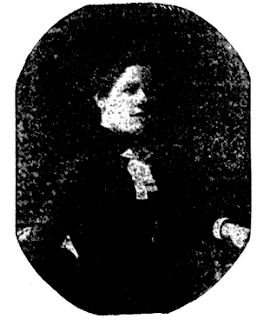This is a work in progress. I've recently found out lots more information so this will have to be rewritten.
Here are some photographs of Elsie:
These were printed in the Illustrated Police News. You can see in the second one she is wearing an apron and elaborate hat, and carrying a tray with a teapot and a cup and saucer. The paper reports they were "taken during the time that she was in service in Oldfield Park." Elsie worked as a domestic servant in various houses around Bath. We know that in the spring of 1890 she was a cook at 3 Norfolk Crescent, a house owned by Mr R.A. Dykes (a manager in the Somerset and Dorset Railway Company). After that she worked for a Mrs Doveton at 38 Green Park. It sounds like it was easy to find new work of this kind (she was 'out of service for about two days' between the two jobs and 'stayed there three months'. It was said 'she was not out of a situation very long'). Perhaps this itinerant way of life meant her initial disappearance drew less attention than it might? That's my pure speculation though.
After that she went to a house in Canynge Square, Clifton, over in Bristol. At some point after that she took a job at Cheriton House in Bath, and was there in the summer of 1891, when she went missing. She left her job there on the Saturday before the August Bank Holiday. From this day to the Bank Holiday, she was lodging with a Mrs Andrew Dillon. This (I think) was on the same road where her ex-boyfriend, Arthur Stevenson Coombs, lived.
The papers immediately leapt upon the sensationalist details of the discovery of her body in September 1893. Her remains (by now skeletal) were found by two local schoolboys who were playing on the Claverton side of Bathampton Down. The bones were under a layer of stones, tucked inside a cave in an old quarry. Her skull was fractured above the left eye. We wouldn't think the forensic handling of the crime scene terribly good by the standards of today - a reporter was there trampling about and writing everything down in a ghoulish fashion. Her bones were taken to the George Inn, just next to the churchyard where they were later buried. It wasn't immediately obvious who the remains were, but scraps of Elsie's clothing remained, and one was marked with the name 'Kerry'. Soon after a man named Dill came forward and admitted that in 1891 he had found a blood-stained hankerchief in the same area marked with the name A.H. Kerry (or perhaps A.A. Kerry). Initially the newspapers reported this as the victim's name, but it transpired that the name belonged to Mr and Mrs Kerry, who owned the house where Elsie had last worked.
Mrs Kerry "identified the linen produced as her property" - and from this the police seem to have deduced the identity of the body as Elsie Luke. The process of this isn't clear from what I've read - after all, I've only got a few newspapers - maybe the police had records of her being reported as missing from the summer of 1891, and pieced it together. It is of course conceivable that it wasn't her! It's not like they used dental records or DNA to identify her, and I'm guessing she wasn't the only servant who ever nipped off with a bit of their employer's laundry. But I suppose we must assume that the body found was Elsie's.


Hello, we admire all the hard work and the intelligent observations that you have made. We are deeply intrigued by Elsie's story and are in the process of making an audio story about Elsie in collaboration with Theatre Royal Bath and would be very interested in any contribution you could make to help us flesh out this story. Please email us at bathmysteries@gmail.com to get in contact!
ReplyDeleteThere is a book called Victorian Murders that covers this, if you haven't alreasy read it?
ReplyDelete